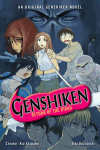
When I saw "Genshiken: Return of the Otaku" in my local bookstore, my heart skipped a beat. As any other Genshiken fan, I couldn't believe that there might be any more to that great storyline. It was especially pleasing to see that the Shimoku sensei contributed original artwork to the project. This is a paperback book and not a manga, and the actual author is Iida Kazutoshi. In the notes from the original author and artist at the end of this book, Kio Shimoku throws his gravitas behind the book and assures the reader that this too is also Genshiken.
Shimoku-san and Kazutoshi-san, I am terribly, terribly sorry (insert American style shoulder bows three times here) but I must decline the invitation to accept GenReOta as Genshiken canon. Please, let me explain.
It is of course natural that any proposed contribution to the Genshiken universe(s) would be just the sort of thing that would invite the Genshiken treatment, namely the sort of picking apart of a manga or anime that the Genshiken members would do. Unfortunately, I'm sure that if you ask them to answer the question of canonicity, the Genshiken would immediately say that the attribution of Genshiken status to GenReOta is an act of supreme generosity rather than one of true recognition.
There are predictable difficulties in any work that bears tribute to another original work. One is that it must connect to the fanbase of the original by making sure the author's established tropes for the characters and the setting are recognizable in the tribute. This leads to a lot of redundancy and tends to reduce the original characters to being two or even one dimensional behavioriods. This problem is aggravated in a Genshiken tribute because the original characters were so well developed. Indeed, this was one of the features of the original manga that made it stand out among the increasingly crowded manga market. GenReOta is no exception this difficulty. The reader tends to think, "Okay, I get that I am supposed to think that your Madarame is the Madarame. Please stop reminding me."
But even setting this standard, the story fails to meet it. In the original manga, a clear line is drawn between the world of the 'real' life of the members of Genshiken College Circle and the fantastic although analogous 'lives' of their favorite manga characters. I would say the integrity of this level distinction is a device crucial to the original manga. Its success as a story is part due to Shimoku's careful exploiting of this device. But this feature is thrown out in the book. This story (without spoiling it) is a fantasy story where some unreal things happen to the Genshiken members. This treats the Genshiken world like the Kujibiki Unbalanced world. In consequence of this, another crucial feature of the Genshiken manga is lost. The great twist in Genshiken series is that it is a coming of age story involving characters that are supposedly going through a protracted adolescence. The drama is in seeing who matures and who well they do, given the self-imposed hurdles. But GenReOta just is a shonen story. If it weren't for Shimoku's illustrations, we'd imagine the characters with big eyes and their speech in extra dark fonts.
That says enough to be a sufficient defeater for canonicity. However, there are other issues. Just to mention three; all of the characters as I said are flat and formulaic but Kasukabe-san is not only flat but wrong. In the story, Kasukabe is presented as a much more vulnerable and indeed much more girly than she is in the manga. As a character, she seems more like Sasahara's sister than the true secret behind the Genshiken's prosperity. Her original choleric driving nature is simply reduced to hitting Madarame. But Kasukabe is a force of nature. Even the hits have no real context in the story like the almost always do (if not always) in the original manga. What we have instead is the shonenization of Kasukabe. Second, why is Kuchiki in the story but not Ogiue, when they both joined the circle at the same time? Finally, there is no Kujibiki Unbalance references at all in the story, no doubt because that would betray that absence of the main story device.
So GenReOta is a shonen story with some of the main characters from Genshiken, also 'shonenized' for the sake of the story. I implied nothing about what I think of it as a story in its own right. But I would rather not think of it as official Genshiken, with all due respect.
There is one part of the book, however, to which I wholeheartedly concur. That is the sentiment expressed by Kazutoshi-san in the last page of his story.
